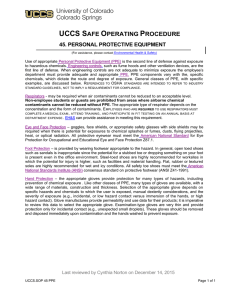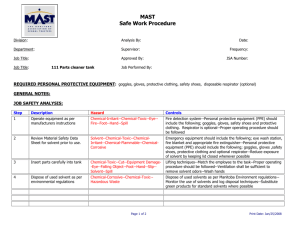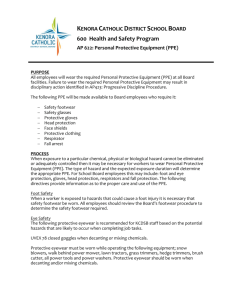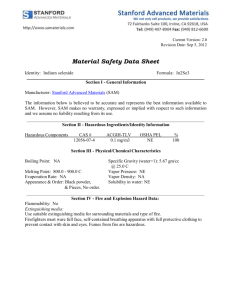Guidelines for the Use of Personal Protective Equipment
advertisement
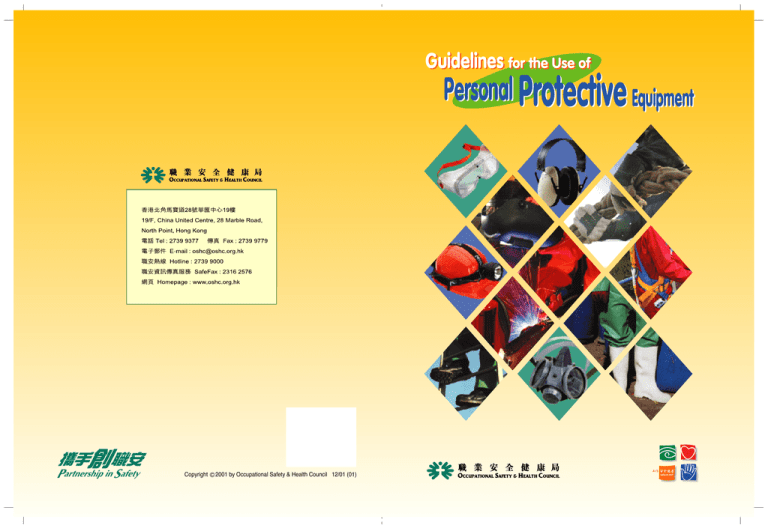
Guidelines for the Use of Personal Protective Equipment Copyright 2001 by Occupational Safety & Health Council 12/01 (01) Contents Introduction 1 Key Points on the Proper Use of Personal Protective 2 Equipment Safety Helmets 3 Eye Protectors 4 Ear Protectors 5 Respirators 6 Protective Gloves 8 Safety Belts 10 Safety Footwear 12 Protective Clothing 13 * This booklet is also available in Chinese version 15 Introduction Personal protective equipment (PPE) is an important means of preventing work injuries. Ideally, the best approach is to maintain a safe work environment and eliminate any potential hazards. PPE should only be relied upon as a last line of defence in places where it is not practicable to control the hazards at source. The use of PPE generally implies working in a potentially hazardous work environment and its use is a major means of injury prevention. Therefore, it is of prime importance to ensure that the equipment chosen is both reliable and effective, it is being properly used and maintained, and the user has undergone adequate training. The aim of this booklet is to raise the awareness of occupational safety and health practices and the proper use of PPE of people from all walks of life. 1 Key Points on the Proper Use of Personal Protective Equipment (1) Proper selection You must first understand the nature and degree of the potential hazards, and then select appropriate PPE that meets the relevant standards. Furthermore, some PPE (such as breathing apparatus) must properly fit the physique of the user before they can be effective. PPE must meet the demands of the work environment and should be as comfortable and easy to use as possible. (2) Correct use You must fully understand and abide by the correct usage methods of the PPE. Examples of incorrect use include different brands of filter being fitted to a respirator or the filters being cleaned with water. (3) Correct maintenance PPE should be cleaned and dried after use, properly stored and regularly inspected. If you discover any damage to the PPE, you should immediately report this to your supervisor so that it can be replaced. 2 Safety Helmets The "Construction Sites (Safety) Regulations" clearly state that no person shall enter a construction site without wearing a suitable safety helmet. In other places where there is the risk of falling objects, workers must also correctly wear safety helmets to avoid head injury. Safety helmets must: Safety helmets require proper maintenance. You must not: 3 Eye Protectors Our eyes are highly susceptible to injury from external hazards that can lead to partial or complete blindness. The "Factories and Industrial Undertakings (Protection of Eyes) Regulations" state that proprietors must provide suitable eye protection to employees undertaking certain processes and to others affected by those processes. Introduction to various kinds of eye protection equipment: (1) Protective goggles Suitable for protection from dust, particles, flying chips, chemical splattering and smoke. (Goggles with direct vents are not suitable for protection from chemical splattering or smoke) (Fitted with indirect vents) (2) Safety glasses Suitable for protection from particles, flying chips and the impact of fragments. (Frontal protection) (Fitted with side protection) (3) Goggles for protection from glare, gas welding and smelting furnaces Suitable for smelting furnace work (with an added face shield), glare, molten metal, strong light and gas welding etc. (4) Electric arc welding helmets and face shields Suitable for protection from electric arc welding, electric sparks, strong UV-radiation (can be used together with safety goggles) etc. 4 Ear Protectors Working under prolonged exposure to high levels of noise can lead to hearing loss. Intermittent exposure to high noise levels can lead to irritability, a reduced ability to concentrate, hearing damage and can even lead to accidents. Once hearing is damaged, it cannot be restored so we must protect our hearing. The "Factories and Industrial Undertakings (Noise at Work) Regulation" requires proprietors to provide their employees with approved ear protectors. Different types of ear protectors: (1) Cotton earplugs Disposable earplugs for short-term use not suitable for high noise levels. (2) Elastic earplugs Cleanable, reusable earplugs (3) Foam earplugs When compressed and inserted into the ear cavity, they expand to completely fill the ear cavity. (4) Ear muffs Ear muffs offer a high level of sound reduction and are suitable for high noise levels. They can be used in combination with a safety helmet The correct use of earplugs Pass your left hand behind your head and lift up the top of your right ear to open up the ear cavity. Insert the earplug into the ear cavity, pressing and turning lightly. 5 Respirators The air quality of the work environment has a direct influence on the safety and health of employees. Ideal protective measures are to control any source of pollution and reduce the amount of pollutants entering the air supply. If circumstances do not allow such measures to be immediately taken, the best strategy is to ensure proper selection and use of appropriate respirators. Common kinds of air pollution If you encounter the following hazardous situations, you may require the protection of an appropriate respirators: (1) Inadequate oxygen supply in the air (less than 19% oxygen) (2) Presence of toxic gases Including gases (such as hydrogen sulfide) and volatile substances (such as benzene) (3) Harmful particles Including noxious dust (such as marble, chalk etc.), pneumoconiosis – causing dust particles (such as silica and asbestos) and toxic particles (such as lead dust and acid mist) (4) Any combination of the above 6 Respirators Different types of respirators There are basically three kinds of respirators for protection from the above-mentioned hazards: (1) Dust respirators (3) Breathing apparatus (Not suitable for oxygen deficient environments) (2) Cartridge or canister (Not suitable for oxygen deficient environments) (a) Self-contained Breathing apparatus (b) Linked to an air supply system Essential points to consider before using a respirator: 1. 2. 3. 4. 5. Selection of appropriate respirators according to the results of risk assessment, and provision of training and information in the proper use and care of the respirators. Medical examinations should be carried out to screen which employees are suitable to carry out certain tasks that need wearing the respirators. Inspection of the respirators should be carried out before work is commenced to ascertain whether there are any damages to the respirators and whether they are suitable for the existing work environment. Checking whether the cartridge or canister works effectively. Carrying out a proper fit test to ensure the respirator fits tightly against the face. Regulations currently in effect regarding respirators: 1. 2. 3. 4. 5. Factories and Industrial Undertakings (Confined Spaces) Regulation Factories and Industrial Undertakings (Asbestos) Regulation Factories and Industrial Undertakings (Dangerous Substances) Regulations Factories and Industrial Undertakings (Blasting By Abrasives) Special Regulations Construction Sites (Safety) Regulations 7 Protective Gloves Using your hands is an almost indispensable part of any job and thus there is always the risk of getting your hands injured. You must therefore select appropriate hand protection. Furthermore, if your hands are likely to come into contact with harmful or corrosive chemicals resulting in rashes or skin inflammations, products such as protective ointments can be used to provide extra protection. The regulations also expressly state that proprietors shall provide sufficient supply of protective skin ointments to workers involved in electrolytic chromium processes. Common protective gloves: 8 (1) Gloves for common tasks (cotton/ leather) (2) Gloves for handling chemicals (3) Heat-resistant gloves (4) Cold-resistant gloves Protective Gloves (5) Cut-resistant gloves (6) Anti-shock gloves (7) Disposable gloves (8) Gloves for electrical work Protective gloves must have a good tactile sense, elasticity and dexterity. They must not be slippery and must be easy to put on and take off. They can be made of materials such as cotton, latex, nylon or leather. The appropriate kind of gloves should be selected according to the nature of the work. The only places gloves may not be used are situations where the gloves might get tangled up in moving parts of machinery such as drill spindles and revolving cutting tools. Regulations currently in effect regarding protective gloves: (1) Factories and Industrial Undertakings (Electrolytic Chromium Process) Regulations (2) Factories and Industrial Undertakings (Dry Batteries) Regulations (3) Factories and Industrial Undertakings (Dangerous Substances) Regulations 9 Safety Belts For working at heights, the safety regulations require employers to adopt basic safety precautions including the provision of suitable working platforms, safe access and egress and the erection of suitable guardrails at hazardous locations. If these safety precautions are not feasible, safety belts must be used. The regulations require safety belts to be use in the following hazardous situations: (1) Regulation 38H of the "Construction Site (Safety) Regulations" states the condition where and when safety belts are used. (2) Regulation 38I of the "Construction Site (Safety) Regulations" describes the duty to wear safety belts. (3) The use of suspended working platforms under regulation 15 of the Factories and Industrial Undertakings (Suspended Working Platforms) Regulation (4) The use of a receptacle of less than 900mm deep for carrying persons by a lifting appliance under regulation 18B(1) of the "Factories and Industrial Undertakings (Lifting Appliances and Lifting Gear) Regulations". (5) Working in a confined spaces under sections 9 and 10 of the "Factories and Industrial Undertakings (Confined Spaces) Regulation". Other examples of situations where safety belts are required: (1) Working on container tops during cargo or container handling under regulation 10B of the Factories and Industrial Undertakings (Cargo & Container Handling) Regulations (2) Working at a dangerous place which requires alternative protection under regulation 24(a) of the Factories and Industrial Undertakings Regulations. (3) Working at a dangerous place which requires alternative protection under section 6(1)(b) of the "Occupational Safety and Health Regulation". 10 Safety Belts Common types of safety belt: (1) Full body harness is used to prevent falls. (2) General purpose safety belt and its lanyard are used to restrict movement while working. General purpose safety belt and its lanyard Fall protection system for working at heights In addition to a safety belt, the entire fall protection system for working at heights must also consider the area surrounding the worksite so as to, for example, prevent striking against nearby structures in the event of a fall. Environmental factors should also be taken into account so as to avoid high temperatures or smoke affecting the performance of each of the components of the system. Fall protection system for working at heights 11 Safety Footwear Accident statistics from the Labour Department reveal that there are many accidents annually caused by stepping on objects and slips. So how can we reduce the risk of foot injuries to employees? Wearing appropriate safety footwear is one of the easy and effective ways. Selection of suitable safety footwear Before making a selection, you must understand the major hazards causing direct or indirect foot injuries to employees. (1) Being struck by hard, rolling or falling objects. (2) Sharp objects piercing the sole or body of the shoe. (3) Being scratched by sharp objects, resulting in epidermal laceration. (4) Slipping on wet floors. (5) Contact with chemicals, molten metals and hot or cold surfaces. (6) If electrostatic discharge is inadequate, explosions may be triggered in environments containing flammable gases. Furthermore, the electrical conductivity of the feet can also affect the risk of electrical shock. Use and maintenance of safety footwear Safety footwear can only work effectively and protect the feet if they are properly used and looked after. (1) You must not alter the structure of the safety footwear yourself. (2) You must wear safety footwear of a suitable size. (3) You must pay attention to personal hygiene and keep your feet and footwear clean and dry. (4) Regularly clean your safety footwear. In addition, the soles of safety shoes must also be cleaned regularly to avoid the build-up of grime. This is because the grime on and texture of the sole of footwear can affect the electrical conductivity of the soles and may also reduce their anti-slip properties. (5) Store your safety footwear in a shaded, dry and well-ventilated place. 12 Protective Clothing Protective clothing provides physical protection and can increase comfort levels while on the job. The following kinds of protective clothing are available, affording protection from different hazards: (1) General purpose protective clothing Including raincoats (2) Heat-resistant work clothing/aprons Used for welding to prevent burns from sparks, fragments and flying molten metals (3) High-temperature work clothing For employees working around smelting furnaces, firemen etc. (4) Low-temperature work clothing For employees working for long periods in refrigerated conditions 13 Protective Clothing (5) Anti-electrostatic work clothing Suitable for workplaces where flammable materials are handled or where static charges might affect the quality of electronic products (6) Impermeable work clothing for protection against chemicals Chemical spill handling and asbestos handling etc. (8) Reflective clothing (7) Life jackets Reduce the risk of drowning when an employee falls into water Such as for working in busy traffic; brightly-coloured reflective clothing can increase the visibility of employees and reduce their chances of being struck by vehicles or machinery (9) Work clothing to prevent cuts Suitable for employees operating sharp blades and machines Regulations related to protective work clothing: Factories and Industrial Undertakings (Electrolytic Chromium Process) Regulations Factories and Industrial Undertakings (Dry Batteries) Regulations Factories and Industrial Undertakings (Dangerous Substances) Regulations Factories and Industrial Undertakings (Asbestos) Regulation 14 Guidelines for the Use of Personal Protective Equipment Copyright 2001 by Occupational Safety & Health Council 12/01 (01)
